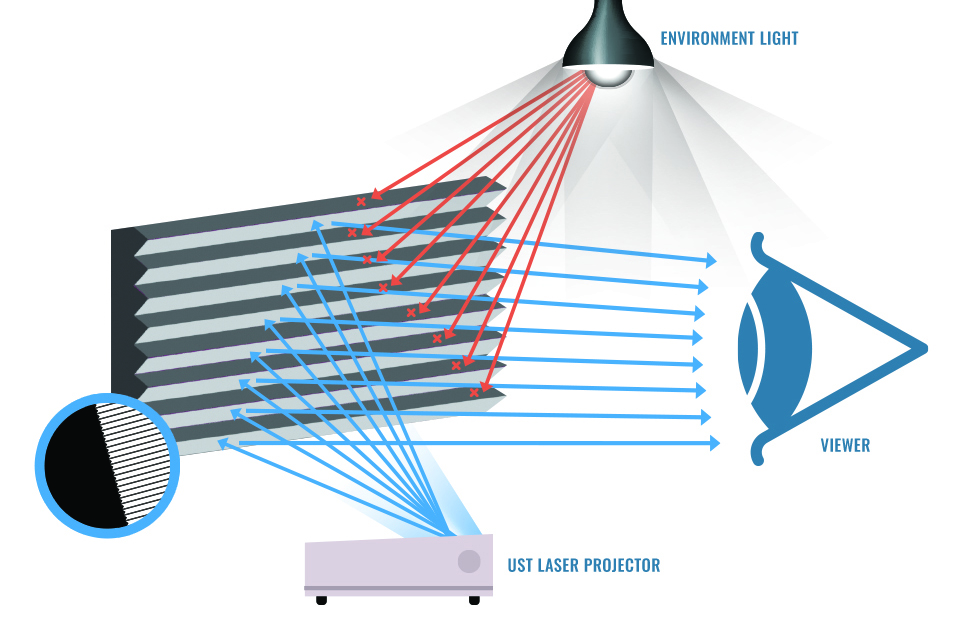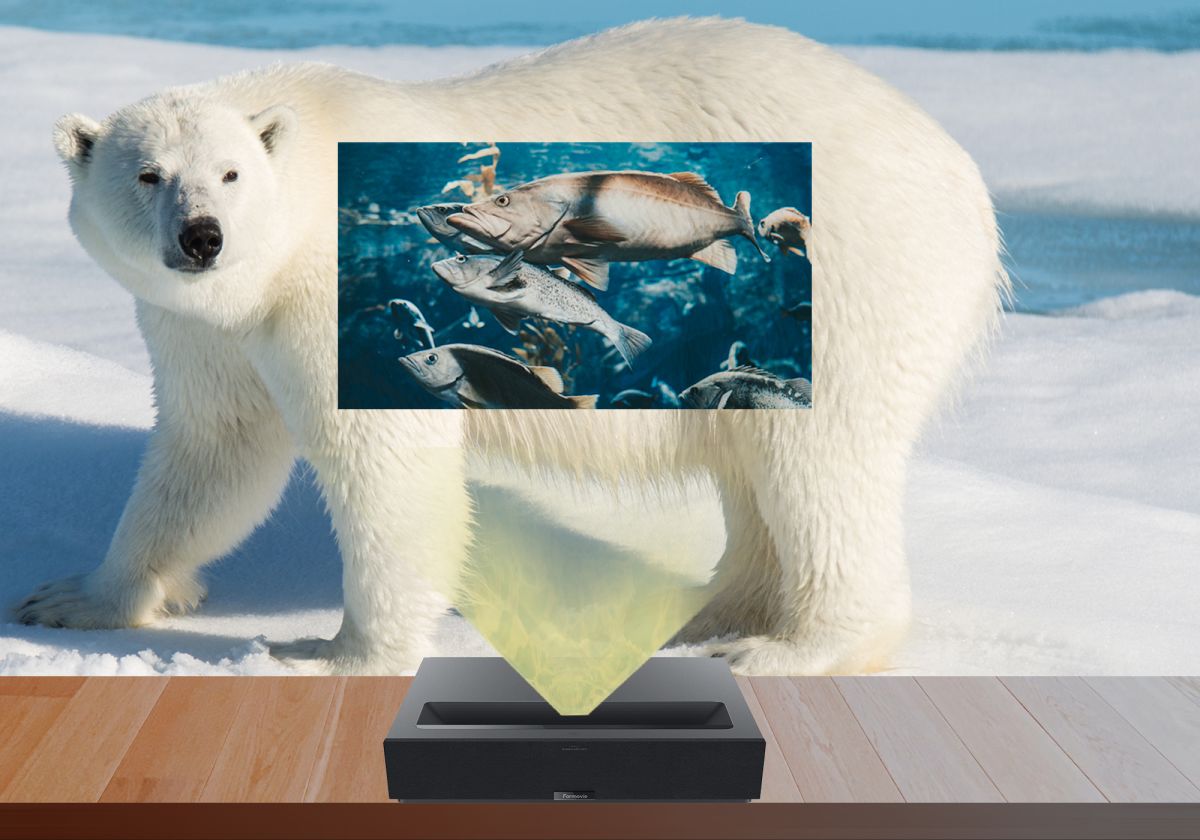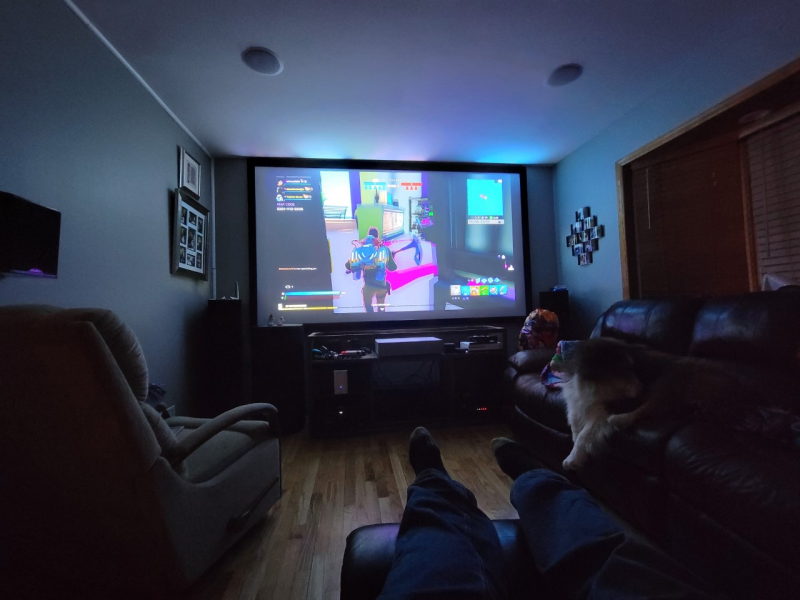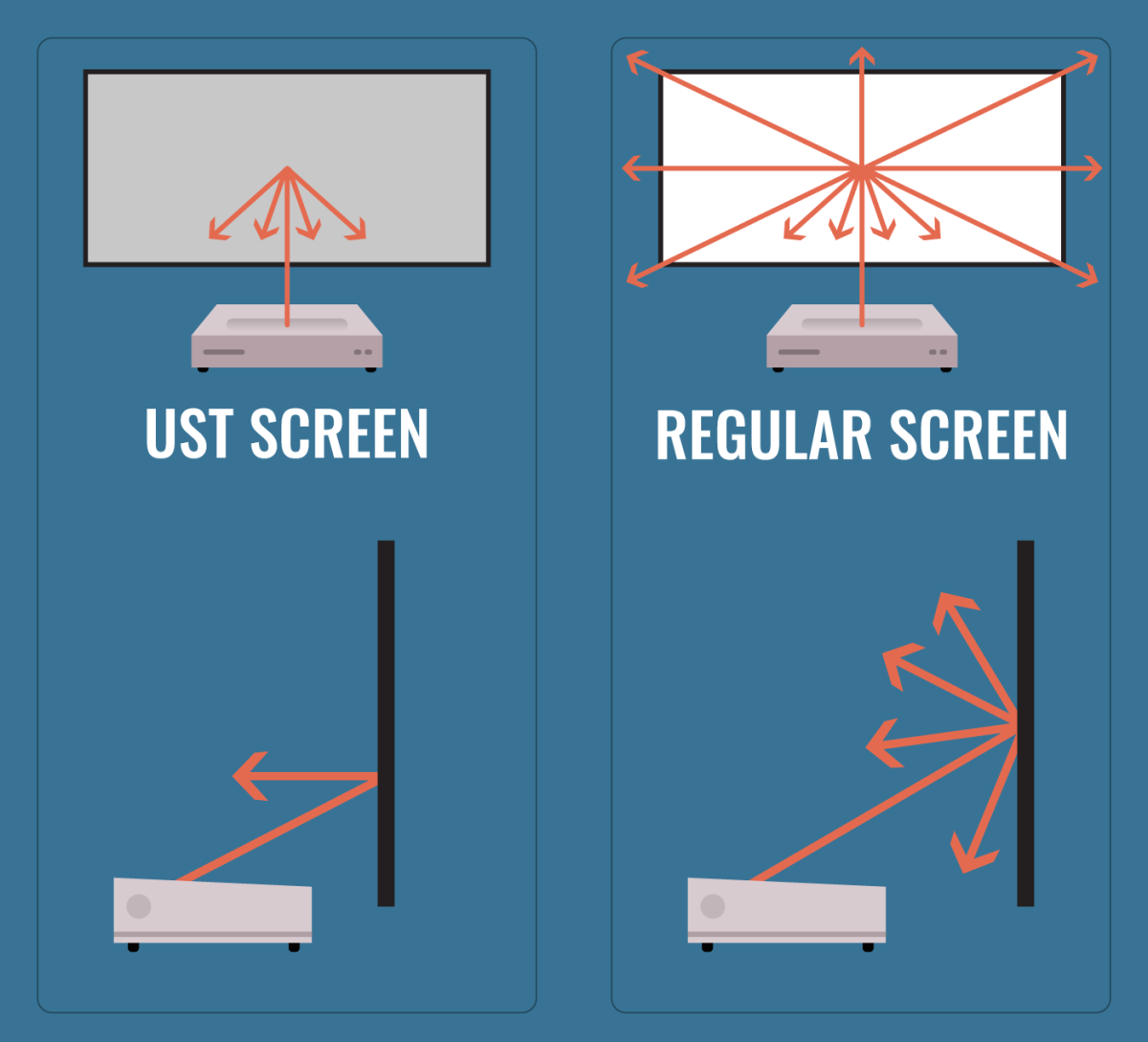Why you want to use a ultra short throw projector screen
When you buy an ultra short throw projector, if you want to get the best image possible and the most out of your device, you need to get an ultra short throw projector screen. These ambient light rejecting screens allow these laser TVs to produce vibrant and bright video in all kinds of well lit and dark environments.
What Is An Ultra Short Throw Projector Screen?
An UST projector screen is a projection surface designed specifically for laser TVs. These screens are built with tiny rows of ridges that are angled so light coming from the projector below the screen is reflected to the viewer, while the ambient light coming from above is absorbed.

What is the benefit of an ultra short throw screen?
These projector screens made for USTs are typically lower gain screens which allow the surface to absorb excess light coming from the projector and prevent hotspotting.
Because they are gray projector screens, they also help provide deeper black levels and improve the perceived contrast of the image.
The frame of a laser TV surface also helps absorb light spill which makes it easier to align your projector.
Do ultra short throws projectors need a special UST projector screen?
Some people may think you can use any regular cinema screen or even a plain white wall to use as a projection surface. Their logic is that movie screens are white so they should work with any projector including laser TVs. This is technically true, but polar bears are also white so they should also work as a projection surface. Yet despite being white, a regular projector screen, plain wall or polar bear are not an optimal projection surface for ultra short throws.
 (Our legal department has insisted we add the disclaimer: DO NOT TRY TO USE A POLAR BEAR AS A PROJECTOR SCREEN)
(Our legal department has insisted we add the disclaimer: DO NOT TRY TO USE A POLAR BEAR AS A PROJECTOR SCREEN)
When it comes to ultra short throw projection, to get the best image you need an ultra short throw projection screen. Additionally, if you want to watch media in a well lit room you require the ambient light rejecting surface found on a ultra short throw screen.
Without it, if you try watching content with the lights on using a regular screen your image will appear dull and washed out.
Why are ultra short throw screens better for USTs than other projection surfaces?
UST Screen Vs. Regular Projector Screen Vs. Plain White Wall
Ultra Short Throw Projector Screen |
Regular Projector Screen |
Plain White Wall |
Ambient light rejection allows your UST to thrive in any room | No ambient light rejection, only ideal for a dark room | No ambient light rejection, only ideal for a dark room |
Provides a flat projection surface | Fixed frame and tensioned screens provides a flat projection surface | Bumps, scratches and texture give a rough image |
Some projection surface can render 4K image | Some projection surface can render 4K image | Textured surface doesn't allow for true 4K image |
No ceiling reflection. Light is concentrated and reflected off the screen towards the audience | Light bounces off the screen in all directions illuminating ceilings and walls. (also washes out image and diminishes contrast) | Light bounces off the screen in all directions illuminating ceilings and walls. (also washes out image and diminishes contrast) |
Premium screens are color balanced to give you a tint free image | Premium screens are color balanced to give you a tint free image | Even with a white wall, image will appear tinted |
Gray surface provides deeper black levels | Black levels won’t be as deep as with a gray surface | Black levels won’t be as deep as with a gray surface |
Negative gain surface prevents hotspotting | Neutral or high gain surface can cause hotspotting with the projector sitting so close to the screen | Surface is likely negative gain and probably won't have hotspotting |
Bordered screen provides a rectangular framed image (also improves perceived contrast) | Bordered screen provides a rectangular framed image (also improves perceived contrast) | Picture will not be perfectly rectangular but more like a trapezoid |
|
Dynamic Contrast Off |
Dynamic Contrast Normal |
Dynamic Contrast High Speed |
Dynamic |
1,293:1 |
4,861:1 |
224,083:1 (Full Fade to Black)
22,253:1 (With Single Pixel) |
Vivid |
899:1 |
2,204:1 |
4,527:1 |
Cinema |
720:1 |
1,700:1 |
3,566:1 |
Natural |
622:1 |
1,484:1 |
3,003:1 |
What happens when you use a regular screen with a UST projector?
While using a regular projector screen with a laser TV technically works, try watching content with the lights on. The image will appear dull and washed out. But if you use an ultra short throw projection screen, the ambient light is rejected, while the light coming from your projector reflects back to the viewer. This gives you a bright and vibrant image.

Even with the lights off, the laser TV cinema screen will produce a better image than you’d get using a normal projection surface.
Regular Projector Screen
 The light on the ceiling and walls lights up the whole room.
The light on the ceiling and walls lights up the whole room.
The Image lacks contrast. It looks flat and dull.
UST Projector Screen
 Much less light scattered in the room.
Much less light scattered in the room.
Image looks sharp and bright.
So, why does the image look so much better on the ultra short throw screen than on the regular one even in the dark room? The answer lies in the surface technology.
Ultra short throw projector screens are built with rows of angled ridges that are light absorbing on top and reflective on the bottom. This allows the light coming from below the screen to be reflected back towards the viewer while ambient light from above is absorbed.

These ridges also help the UST projector screen in the dark. Because the light is coming from underneath the surface and reflected towards the viewer, you don’t get a scattering of light around the room like you would with a normal projector screen.
What screens won’t work with a UST projector?
While there are some regular movie screens that will work with a laser TV, not all of them will. You need to be mindful about this if you already own a projector screen. These are the types of screens that won’t pair well with an ultra short throw projector:
High Gain Surfaces
Since the UST sits directly below the display surface and uses such a bright laser light source, a high gain screen will cause hotspotting.
Non-UST Ambient Light Rejecting Screens
The lenticular structure of these screens only allows for light from across the room. If you use one of these CLR screens with a UST the image will look dull and not bright.
Screens With A Deep Border
Because the laser TV sits directly below the projection surface, a movie screen with a deep border will block the light from the projector from hitting the screen.